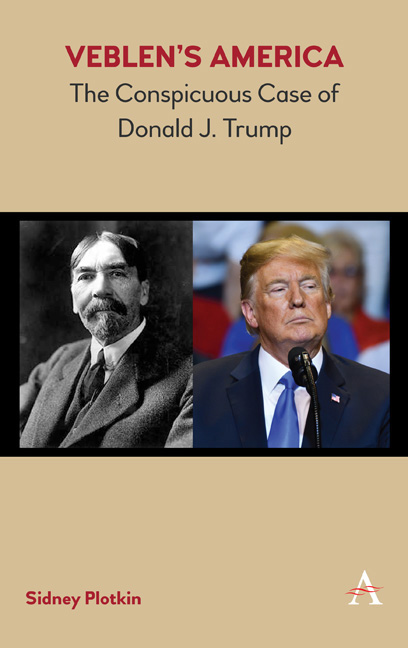Book contents
- Frontmatter
- Dedicaton
- Contents
- Acknowledgments
- A Note on Citations
- Chapter One Introduction: Donald Trump through Veblen's Looking Glass
- Chapter Two Evolution, Institutions and Barbarism
- Chapter Three The American Plan: Barbaric Liberalism
- Chapter Four Trumpian Ancestors, Exploitative Legacies
- Chapter Five Building for the Leisure Class
- Chapter Six “Picturesque Accompaniments”
- Chapter Seven Candidate Trump and the Politics of Popular Rage
- Chapter Eight Barbaric Governance
- Index
Chapter Three - The American Plan: Barbaric Liberalism
Published online by Cambridge University Press: 09 April 2019
- Frontmatter
- Dedicaton
- Contents
- Acknowledgments
- A Note on Citations
- Chapter One Introduction: Donald Trump through Veblen's Looking Glass
- Chapter Two Evolution, Institutions and Barbarism
- Chapter Three The American Plan: Barbaric Liberalism
- Chapter Four Trumpian Ancestors, Exploitative Legacies
- Chapter Five Building for the Leisure Class
- Chapter Six “Picturesque Accompaniments”
- Chapter Seven Candidate Trump and the Politics of Popular Rage
- Chapter Eight Barbaric Governance
- Index
Summary
This American Plan began at the beginning, and has continued. It is not peculiarly American, except in the sense that it has been worked out more consistently and more extensively here than elsewhere, and that it has been worked into the texture of American life and culture more faithfully […] The American Plan or policy is very simply a settled practice of converting all public wealth to private gain on a plan of legalized seizure.
Ancient barbarism gradually pacified itself. Its cruder habits of coercion evolved. They matured and perfected themselves, achieving their most civilized form in the settings of feudal Europe and Japan, where class and status distinctions based on birth were rigidly observed. None were more pressing than abrasive contrasts between leisure and labor. Under feudalism, barbarians nurtured refinement and taste; they assumed a new grandeur of style and bearing. They put on white gloves. Barbarians became aristocrats, a nobility ever prepared to lead combats that spilled the blood of lesser men. But the addition of leisurely pursuit to the armature of aristocratic showmanship did bear out Veblen's assessment of change. The evolution of feudal aristocracy slowly altered the civilization of barbarism, rendering it more attentive to wastefully conspicuous consumption as its preferred certificate of honorific rank. In this way, aristocratic barbarians became more than soldiers and sportsmen. They became connoisseurs of art, collectors of many things, performance artists of regal display. Increasingly, large- scale ownership itself loomed as the approved condition of civility and high culture. Big property and large accumulations of wealth were imperative. Appropriate symbols of prowess could not be acquired otherwise. But more profoundly, such symbols expressed the singular trademark that always and everywhere distinguished the true barbarian: social immunity from the taint of having to perform useful labor or to engage the life process at anything less than a far remove.
Just as their less refined ancestors, these now cultivated leisure classes lived many stations above the dirty daily work of everyday life. Industry was for uniformed servants and flunkies, underlings and peasants, tainted others who labored and produced under the watchful disdain of their superiors. Their bodies and work were treated with every form of haughty dismissiveness, the product of their effort immediately seized. Donald Trump, of course, shares the old contempt for work of the hand, but he also shows little patience for refined aristocratic pretension.
- Type
- Chapter
- Information
- Veblen's AmericaThe Conspicuous Case of Donald J. Trump, pp. 65 - 102Publisher: Anthem PressPrint publication year: 2018

